1970 South African Grand Prix race report: Brabham schools the kids
In the face of a new wave of challengers, experience counts for Jack Brabham as he takes the win ahead of McLaren’s Denny Hulme and Tyrrell’s Jackie Stewart
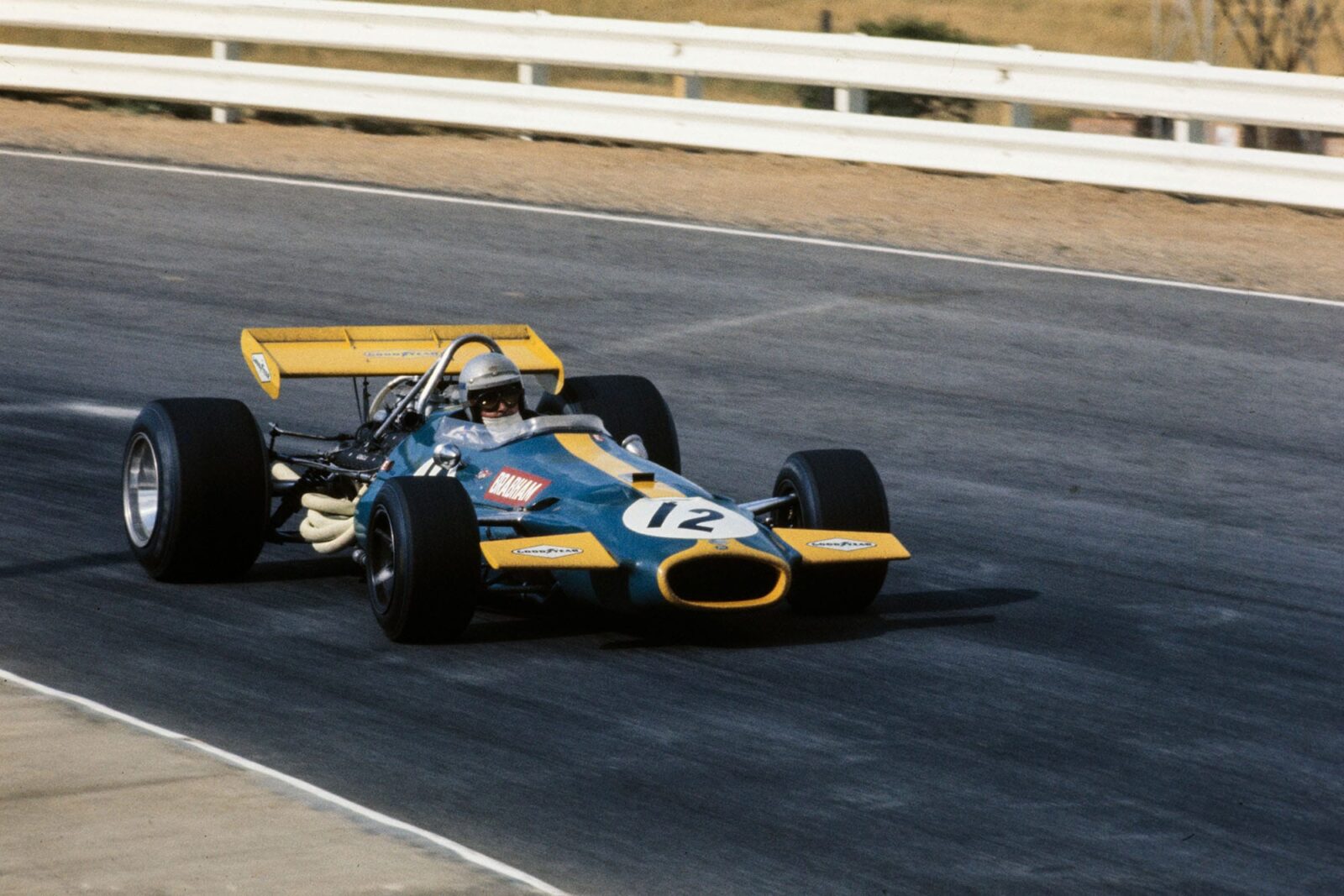
Brabham won the opening round of the season for his eponymous team
Motorsport Images
With the break in Grand Prix racing from November, 1969, to March, 1970, all the teams, and some new ones, made remarkable efforts to be ready for the new season well on time. The result was that of the 23 cars that should have assembled for practice, 15 of them were about to be driven in their first competition.
In addition there were a remarkable number of first occasions as well, such as the appearance of the March cars and teams, the flat 12-cylinder Ferrari engine, the new Matras, McLarens, BRMs, Brabhams and the De Tomaso. New drivers and new driver/team combinations were rife, such as Ickx with Ferrari, Hill with Rob Walker, Surtees with his own team, Stommelen in a Formula One car for the first time, and Amon and Surtees experiencing Cosworth V8 power after years of sitting in front of V12-cylinder engines. From the first pit, occupied by Stewart and the Tyrrell March team, to the last pit occupied by Siffert and one of the STP-March cars, there was enormous activity.
Qualifying
There was only one absentee when practice began promptly at 2:30pm on Wednesday, March 4th, and that was Andretti and the STP Oil-Treatment Special (Or March 701/3 by any other name) for the Italian-born American had overcooked things the day before in an unofficial practice session and bent the rear end rather badly.
The new BRM cars made a very brief appearance for Oliver’s car broke a rear hub-shaft before he could record a time, and as this was the second one in a few days the Rodriguez car was withdrawn at once before it suffered the same fate and only the 1969 car was left circulating, with Canadian driver Eaton learning his way around.
Stommelen had arrived direct from Sebring, where he had been testing with Alfa Romeo, and was soon making a good impression on everyone, especially Brabham and Tauranac, who were thinking of ways of slowing him down a bit until he got more experience. After a 917 Porsche, the new Brabham BT33 was a dream to drive, but Stommelen’s progress was stopped when the rear anti-roll bar broke, much to the surprise of designer Tauranac.
Stewart’s car had been having an engine change during the morning (teams nowadays changing their Cosworth power units the way some people change their oil) and on the new engine the fuel pump pressure was low so practice was nearly over before he came out to make his first official appearance in a March car. Some people thought Tyrrell was being wise and clever and waiting for the heat of the afternoon sun to abate, but they were wrong. The Tyrrell/Stewart combine were just not ready and came out in a disorganised rush so that Stewart never really got into the swing of things.
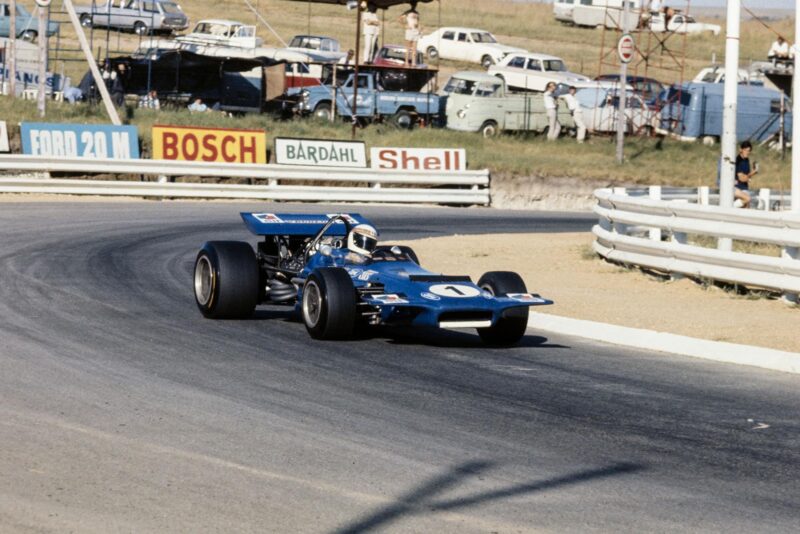
Jackie Stewart took pole for Tyrrell
Motorsport Images
All the pre-practice baloney of tyre-testing and prototype-testing, with fantastic lap times by Stewart and Rindt, was all put in its proper perspective when no-one improved on the 1969 best time of 1min 20sec, and Rindt and Hulme tied for best time with 1min 20.1sec. The Cosworth part of the De Tomaso project was being troublesome, which was finally traced to a fault in the Lucas distributor, and Love’s Cosworth engine went bang as he passed the pits. Rindt promised everyone a huge improvement once he had got over being tired after flying to South Africa, but next day this turned out to be one-tenth of a second.
“Brabham is Brabham and on a circuit he enjoys the results are obvious”
The Tyrrell team were more organised on Thursday afternoon and Stewart was first away and setting the pace with an improvement of well over one second and 1min 19.3sec was the time to beat. Brabham was down to 1min 19.6sec without any pre-practice sessions at Kyalami or expensive Goodyear tyre-testing “jollies” to South Africa, and during the afternoon there was an uneasy flutter in the pits when Anion recorded 1min 19.3sec in the red March.
Stewart was expected to be fast, even with a new car, Brabham is Brabham and on a circuit he enjoys the results are obvious, but Amon to equal Stewart with a new and unraced car was another matter altogether. Either the March was an outstanding car, or everyone was being a bit mediocre and the answer to that was pretty obvious; Graham Hill was making excellent progress in the Rob Walker Lotus in view of the fact that walking was still a considerable strain, but his progress stopped during the afternoon when the fuel-injection pump drive broke.
However, it was not before he had decided he was fit enough to take part in the race, which meant that Redman, who was in attendance as a standby, would not get a chance to drive. With a spare Ferrari available it was a pity his talents could not have been used. The day ended with Stewart and Amon equal fastest with new March cars from opposing camps and tyre companies, and Brabham just behind them, these three being the only ones to get under 1min 20sec for a lap, though there were a number of runners, like Rindt, Hulme, Surtees and McLaren who were on the brink of joining this elite.
By the time the final practice began on Friday afternoon tension was running high and a last-minute battle of some ferocity was expected for the front row of the grid. Andretti now joined in officially and the new BRMs were back in the fray, the troublesome hub-shafts being replaced by stronger ones. Track conditions were not ideal, the sun was very hot, there was a lot of rubber about the place and Oliver laid some oil when the tank on his BRM split, so that the expected last-minute battle fizzled out and only by terrific effort was Rindt able to crack the 1min 20sec bogey-time and no-one else managed it.
Brabham spent some time showing Stommelen the way round, until his right rear tyre went flat and the young German had to go on his own. The BRM engines were running very badly, but going surprisingly fast even so, and Charlton was making a good impression by his neat driving, but needed a bit more forcefulness to stay with the works drivers. The faster cars were being timed at close on 175mph just after the pits, and Andretti and Siffert were challenging each other as if they were in rival teams. Redman was allowed half a dozen laps in Walker’s Lotus, in ease Hill could not go the whole distance, and during the last 30 minutes all the “aces” had a real go, but conditions were against anyone improving significantly.
Race
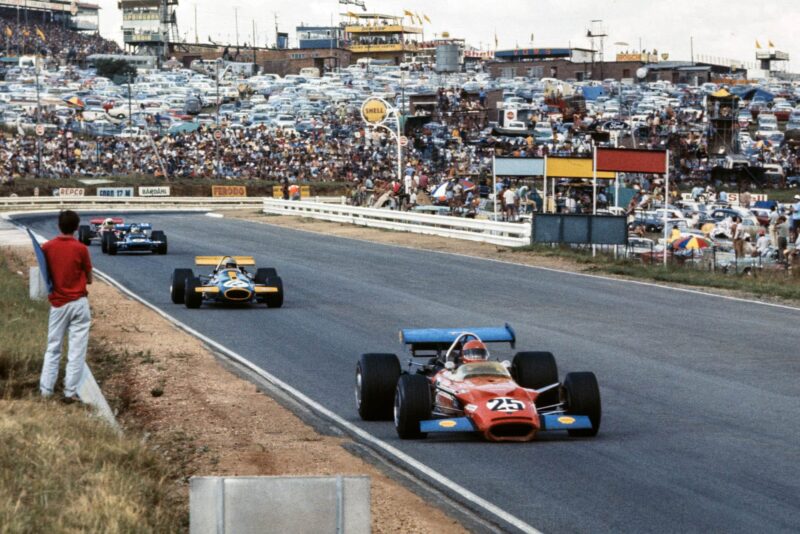
John Love leads Brabham
Motorsport Images
After some evening storms Saturday dawned bright and clear as well as being very hot, and a crowd of over 80,000 people thronged the circuit to watch some national races before the Grand Prix started at 3pm. There was a short untimed test session for the Grand Prix cars before lunch, and by the time they set off on their warm-up lap for the race itself a few clouds had appeared to reduce the heat of the sun to reasonable proportions.
“Rindt went charging down the outside, clipped a nose fin on Amon’s car, cannoned into Brabham and became airborne”
Of the 23 cars on the grid, 22 got away in a bunch, de Klerk being left behind, and as they rushed down the hill to the first corner Stewart and Brabham were almost side-by-side. What was going to be a terrific race was suddenly upset when Rindt went charging down the outside, clipped a nose fin on Amon’s car, cannoned into Brabham and became airborne as he spun in front of everyone except Stewart.
By reason of brilliant reflex actions on the part of all the drivers there was not a major accident, but it meant that those on the left of the grid got boxed in while those on the right were able to dodge through on the inside of the corner, following Stewart, who was already a hundred yards in the lead. This nonsense put a lot of people right off their stroke, and it meant that some of the lesser runners like Ickx (Ferrari), Oliver (BRM) and Beltoise (Matra) were ahead of Brabham, Hulme and Amon, who should have been challenging Stewart, on practice performances.
After recovering from being charged by Rindt, and convincing himself that his car was undamaged Brabham began to settle down to some serious motor racing and after passing Oliver, Beltoise and Ickx by the end of lap 6 he began to close up on Stewart with a relentlessness that was alarming.
It had looked as though Stewart was going to run away with the race in his new March the way he had done so often last year with the Matra, but this did not seem reasonable and Brabham obviously thought the same thing, as did McLaren and Hulme in the orange McLarens, for these two were regaining their rightful positions after the first-corner nonsense. The BRM debacle was going from had to worse as Oliver was in trouble with his gearbox and Rodriguez had to stop and have his ignition system changed.
Although Stewart was conscious that his initial lead was being whittled away by Brabham, and Hulme and McLaren were also after him, there was little he could do. He was driving as hard as he felt he wanted to, but was not producing the sort of inspired performance that Moss or Clark would have done in similar circumstances. He was conscious of a feeling that he should finish in this first race with the new March, even if he could not win, rather than disappear in a cloud of dust and glory fighting all the opposition to the last.
In consequence Brabham had no trouble in taking the lead on the 20th lap, nor did Hulme when he took second place on the 38th lap of the 80-lap race. As McLaren had been keeping pace with Hulme he would almost certainly have taken third place from Stewart, but before this could happen his Cosworth engine blew up and Stewart could relax in a safe third place.
It began to be obvious that the three drivers who were driving Stewart into obscurity were all running on Goodyear tyres and that the combination of March road-holding and Dunlop traction was not a match for Brabham road-holding and Goodyear traction, or McLaren road-holding and Goodyear traction.
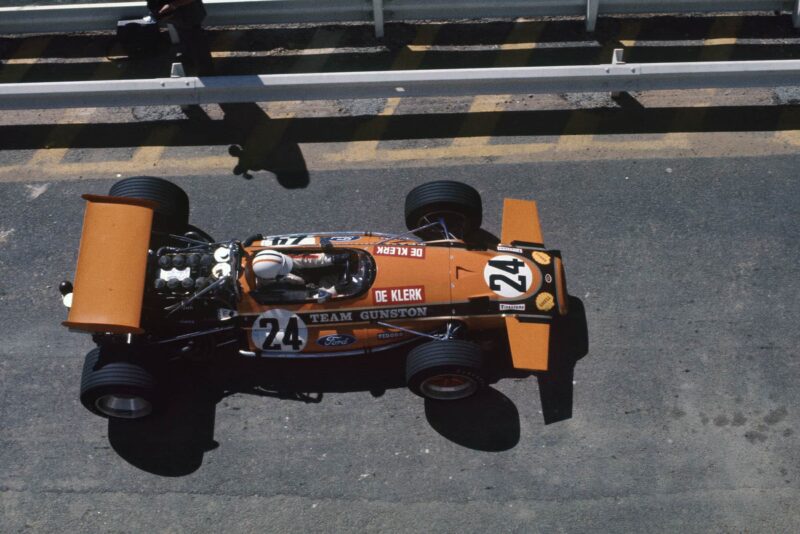
Peter de Klerk finished last and five laps down
Motorsport Images
On the fast plunge downhill through the sweeping right-hand Barbecue Bend, Brabham was terrific to watch, steady and confident, whereas Stewart was not as fast or confident. To have stayed with Brabham would have meant driving on the inspired limit of genius, and Stewart was not prepared to do that, his personal caution settling for a certain finish rather than risking disaster.
“On the fast plunge downhill through the sweeping right-hand, Brabham was terrific to watch”
That was it, Brabham just went relentlessly on, smiling that wily old smile to himself, making a lot of bumptious young upstarts have second thoughts about their driving ability. Hulme sat solidly in second place, like the Rock of Gibraltar, happy that his car was running well, for in practice his fuel system had been suffering from the heat, while Stewart ran cautiously in third place straining neither his car nor his engine, and staying 500 r.p.m. under the top limit.
The other March cars were never really in the picture, Amon was completely demoralised by the first-corner accident and was forced to give up quite early when his water-system header tank split and the engine began to overheat. Andretti never got going properly and suffered the same trouble, but in a more spectacular fashion for the filler and neck of the tank blew right off in a cloud of water and steam. Siffert was never very close to the leaders, though he had a good battle with Ickx (Ferrari) and BeIroise (Matra) for sixth place, and then fifth when McLaren retired, but during the height of the battle he spun and crushed his right-hand exhaust pipe into his oil tank, losing a lot of time at the pits while the flattened end was cut off.
The Ferrari suddenly lost speed as it passed the pits and on the next lap there was a great cloud of blue smoke and it coasted into the pit road with a dead engine, leaving the Matra to hold a strong fourth place, the French 12-cylinder engine never missing a beat.
Pescarolo was not happy with the handling of his Matra, but nevertheless it ran faultlessly throughout the race. Of all the Lotus cars Charlton’s was the most impressive, the South African driver doing very well and actually being ahead of the works cars for a long time and could have been in the first six had a Firestone tyre not stripped a great sheet of rubber off just before the end of the race. Rindt never really recovered from his faux pas and eventually retired with a broken engine, while Miles was badly handicapped by a petrol leak that was threatening to fill the cockpit.
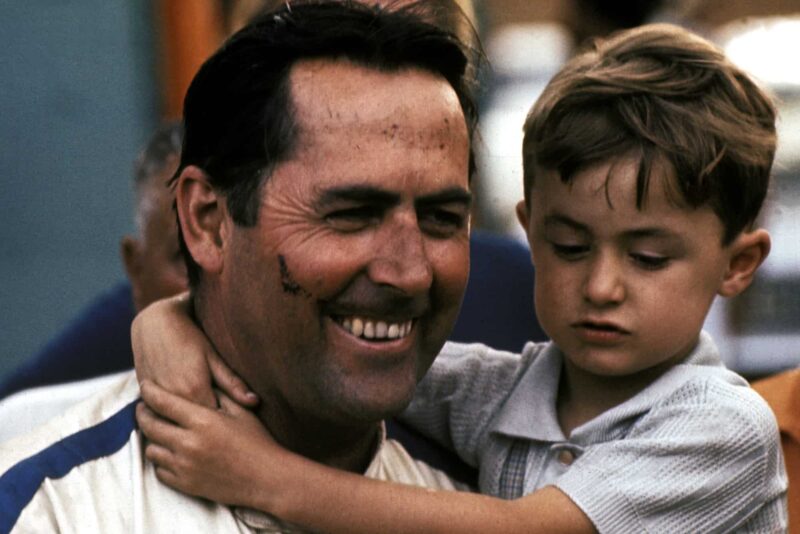
Brabham celebrates after the race with one of his children
Motorsport Images
In spite of this uncomfortable situation he persevered and stayed with Servoz-Gavin and Charlton, and when the fuel tank level dropped sufficiently for the leak to subside he left them both behind and finished in a strong fifth position. Servoz-Gavin went out when his engine overheated and broke due to losing water as on the other two March cars that retired, and Surtees and Stommelen also went out with broken Cosworth engines.
“Although the ‘old brigade’ came out on top, this first race in the 1970 season carried some interesting portents”
Of the 17 Cosworth engines in the race, five of them went back to Northampton for repair and by sheer weight of numbers they managed another one-two-three. The De Tomaso did not figure very strongly on its first outing and when the throttle slides did not shut properly Courage had an unavoidable excursion off into the rough, which damaged the suspension mountings on the right side of the car.
Although the “old brigade” came out on top, this first race in the 1970 season carried some interesting portents, with the first five places filled by different makes of car, a brand new make in third place, and the Cosworth stranglehold being challenged by the French Matra 12-cylinder.
